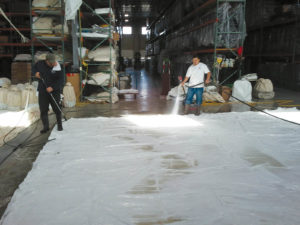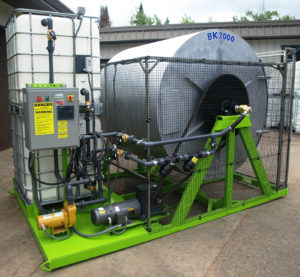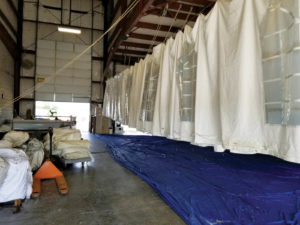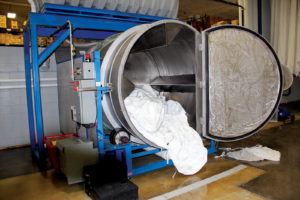
By hand or machine, tent cleaning requires a solid logistical plan to keep tents spotless for every event.
A tent at a job site can encounter many foes that make it dirty: rain, mud, bird droppings, tree sap, wet leaves and even graffiti. To keep inventories pristine and ready for the next event, successful rental companies invest time and resources into tent washing machines and manual cleaning best practices. Paying attention to the seemingly minor details allows renters to offer customers a consistent product every time.
The clean machine
As with any business investment, purchasing a tent cleaning machine requires careful consideration. The conversation between the machine’s manufacturer or distributor and end user typically starts with the types of tents and fabric to be cleaned, how many tents are owned and how frequently they’re used, and the sizes of tent sections, as well as area required for the machine, the washing process and a proper hanging system for drying.
“If a tent renter has a 10-by-10-foot space or space outside, they can have a tent washing machine,” says Steve Arendt, owner of Teeco Solutions, Kirkwood, Mo. “Because the machines are designed to be gentle on the fabric, they turn very slowly and do not require the amount of electrical that a traditional linen washer would require.”
Teeco Solutions offers two styles of tent washing machines, the most popular of which is a rotating drum design that can wash any style tent top or sidewall. For companies with clearspan structures, Teeco has a brush-style washer ideal for washing and drying longer roof panels.

When determining what size tent washer to buy, most rental companies will make the decision based on the volume of tents rented during the busiest times of year. As a guideline, Arendt suggests that the correct size is one that allows a company to “quickly turn dirty tent tops into rental-ready within 24 to 48 hours.”
Traube Tents & Structures, Columbia, Ill., uses the Teeco 3000, its third machine from the company in 20 years. “We gain tremendous labor efficiencies and a consistent clean and dry process for our fabric by using the machine,” says president Steve Traube. “It also is able to get any stitching or webbing clean too, which is difficult to impossible when cleaning by hand.”
In fact, many tent washing machine purchasers cite savings on labor costs as the primary benefit. “They can quickly prep their tent to go into the machine and then have time to do other things,” says Jay Cole, vice president of operations for CCC Washers Inc., a division of Charnecke Tents Inc., Rosholt, Wis. “You do not need to spend hours hand washing tents.”
CCC Washers offers three sizes of compact, fully automatic tent washing machines that clean up to 1,000, 2,000 and 3,000 square feet of tent material, respectively. The machines, which wash all styles of tents and bounce houses, feature a large barrel with a fully enclosed safety cage and are equipped with a heated wash tank and rinse tank. The dual water tanks allow for reuse of water. The machine fills with a garden hose and therefore does not require a special plumbing setup.
Available in widths up to 6 meters, tent cleaning machines from SKP GmbH, Mühlacker, Germany, wash tents using a rolling process rather than a barrel design. This method does not put the tent vinyl under tension. “PVC is pretty sensitive to folding and bending, and if you do too much of it, your material will break at the surface,” says Marcus Luedecke, sales and processing manager for SKP. “Dirt, dust and debris will stay in the breakage area longer, and you can’t clean the material afterward.”

Before selling one of its machines, SKP consults with the customer about the types of tents they will be washing and the setup of the warehouse where the machine will operate. For example, the equipment not only needs the appropriate amount of space to function, it also requires a supply for power, water and pneumatics.
When determining the footprint required for the tent washer, rental shops must consider more than just the dimensions of the machine itself. “You need a loading and unloading zone where you handle fabric,” Luedecke says. “You also need to account for space to walk around and work with the machine.”
SKP, which sells its equipment worldwide, will customize its machines according to the rental company’s unique requirements. After taking measurements of its warehouse, one customer realized it would have to dismantle the roof in order for the equipment to fit inside. Instead, SKP cut the machine into parts to fit through the door, then welded everything together on site.
In the Netherlands, a customer had difficulty cleaning tents that were installed adjacent to the motorway, as the heat from the sun had burned vehicle emissions and dirt into the fabric. SKP adapted one of its machines with special brushes and used a heavy-duty soap to fully remove the pollutants. For another customer in Saudi Arabia, where water supply is limited, SKP created a filtration system that allows the facility to use recycled water when cleaning its tents.
Treat your fabric well
To ensure the long-term quality of tent fabric going through multiple washes, tent washing machine manufacturers advise employing a series of best practices, the first of which is to follow the equipment manufacturer’s recommendations for cleaning solutions. “The best option is to use a cleaner specially designed to wash tent vinyl and another solution for stubborn stains,” says CCC Washers’ Cole.
In addition to the appropriate cleaning agents, using the correct water temperature—95° to 100°F—for the wash and all-rinse cycle “ensures the deepest clean possible but, more importantly, protects the fabric from pinholes and premature wear,” Arendt says.

Arendt also recommends establishing the habit of completely rinsing all chemicals prior to removing the tent top from the washer. This will often require multiple rinse cycles using clean, fresh water to remove all residue. Leaving residual chemicals on the tent top will cause long term stich rot and premature removal of the elements that make the top pliable, according to Arendt.
Although bleach is one of the most effective cleaning agents to combat mold and mildew, tent manufacturers advise against its use. When used with vinyl, bleach can erode plasticizers from the fabric. This eventually leaves the tent brittle and rigid.
But Arendt says that by understanding bleach’s cleaning properties, end users can safely apply and rinse the chemical using a tent washing machine. Bleach from a commercial source is twice as strong as the concentration in household bleach, around 6 percent, and requires more water when diluting.
After measuring an appropriate dilution ratio, users need to determine an exposure time that will allow the bleach to clean the tent without harming it.
“The cleaning power of bleach happens quickly, so getting it on and off the fabric as quickly as possible is key,” Arendt says.
As with other industrial cleaning solutions, incomplete rinsing of the bleach will lead to stich rot and eventual failure. It will also continue eating at the fabric as it is stored. That’s why Arendt suggests a tent washer for the process. “If you use bleach while washing by hand, knowing for sure you have rinsed the entire tent top can be very difficult to gauge,” he says.
Tommy Wilson, director of events services at All Occasions Event Rental, Cincinnati, Ohio, recalls an incident in the heart of the busy season when a 60-by-130-foot tent sat untouched for about two weeks. “It was just the right amount of wet, and when we opened up the tent, there was a little bit of mold and a lot of mildew,” he says. “The tent was only two years old. It was in bad shape.”

The All Occasions team soaked the tent for several hours in a product called Blitz, a mildew remover from Shipp Cleaning Systems that penetrates and kills the spores. “It’s not the best thing to do for the fabric because it takes some of the life out of it, but we were able to salvage the tent,” Wilson says.
Sometimes, nature isn’t responsible for making a mess. A tent from Made in the Shade Tent Rentals, West Sacramento, Calif., was recently tagged with graffiti on the last night of a multiday installation. Warehouse supervisor Hector Guevara used Magic Eraser, water and a lot of hours to remove the offending marks.
“We run in a way that, when busy times hit, we cannot be short of inventory,” says Donny Vasquez, vice president of marketing and special projects. “That means we’ll do whatever it takes to keep our tents rentable.”
Hands-on approach
Although automated tent washing machines offer users many advantages, manual cleaning remains the primary tent cleaning method among many rental companies with small to medium inventories. Washing tents by hand also is preferred for spot cleaning and small stains such as mold, paint or oil.
Made in the Shade Tent Rentals washes all of its tent tops manually using buffers with pads attached. Logistics are a primary driver in choosing manual over machine cleaning. “A machine might take a bit longer, and we don’t have the space to install [a washing machine] or have tents hanging to dry for days,” Guevara says.

up to 6 meters wide, or two 3-meter tents simultaneously. Photo courtesy of SKP GmbH.
Purchasing a washing machine would require Made in the Shade to install a drainage system so the water doesn’t pool on the floor—an impossibility because the company is leasing its building. Local ordinances on electrical and sewage systems further limit options for using a tent cleaning machine.
Given the circumstances, hand washing continues to serve Made in the Shade well. “We thoroughly inspect every tent that has been tagged,” Vasquez says. “We have tents tops that have been in our inventory for 20 years and still go out to this day because of the care of we have instilled in them.”
A solid logistical plan that considers proper tent washing, drying and storage can mean the difference between an event that shines and one that lacks luster. By implementing a series of best cleaning practices, rental companies provide consistently gleaming tents while earning a reputation rewarded by new business.
Holly O’Dell is a freelance writer based in Joshua Tree, Calif.
When determining how often a tent gets washed, rental companies will factor in a number of variables. Traube Tents & Structures washes its tents as infrequently as possible. “Despite advances in detergents and machinery, every wash wears on the life of the fabric,” Steve Traube says. “We average two to three washes per year, but it can vary greatly depending upon usage, type of fabric and weather.”
“If the tent has been up for shorter periods of time, we may get four to five rentals without washing it,” says Tommy Wilson of All Occasions Event Rental. “In between we’re looking at them and hitting a couple of spots. We are at a nice size in terms of volume because we’re able to get away with fewer washes and still deliver the quality.”
Made in the Shade Tent Rentals’ takedown crews use a color-coded system to bag and tag tents, indicating whether the unit is dirty or damaged, and to what degree. “If something is just dusty, we do a wipe-down with towels rather than using a cleaning solution or scrubbing it,” says Donny Vasquez. “If it’s marked as extra dirty, or if it has pollen or has been raining and the tent is a long-term rental, we make sure to scrub it and make it as clean as possible.”
Made in the Shade requires its crews to fill out forms when they deliver the tent and again when they pick it up, prompting workers to inspect the unit. The company also recently started taking pictures of tents before takedown.
“The photography helps with our cleaning process and what we need to do to fix the damage when it comes back in a condition that it didn’t leave in,” Vasquez says.
 TEXTILES.ORG
TEXTILES.ORG


